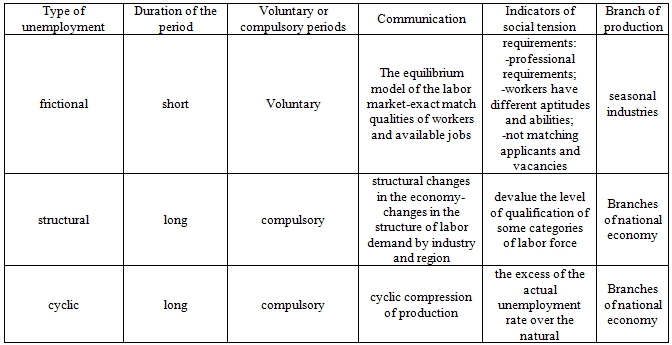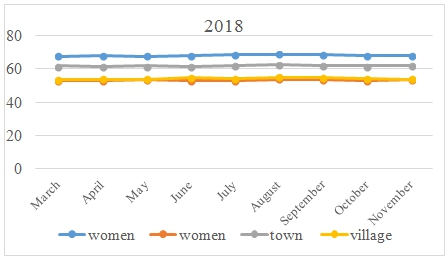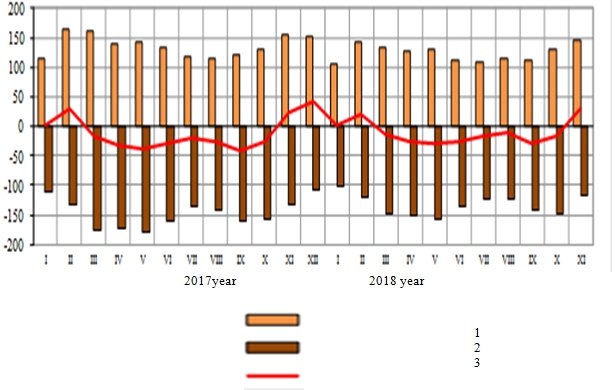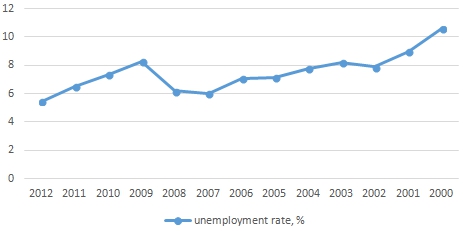БЕЗРАБОТИЦА КАК ФАКТОР СОЦИАЛЬНОГО НАПРЯЖЕНИЯ
БЕЗРАБОТИЦА КАК ФАКТОР СОЦИАЛЬНОГО НАПРЯЖЕНИЯ
Научная статья
Павлова С.А.1, *, Киндрук С.М.2, Чибисова А.М.3, Груздев А.В.4, Бунтова О.Р.5
1, 2, 3, 4, 5 Института государственного управления и государственной службы Российской академии народного хозяйства и государственной службы при Президенте Российской Федерации, Москва, Россия
* Корреспондирующий автор (s_pavlova[at]mail.ru)
АннотацияВ статье рассматривается один из важнейших факторов социальной напряженности в России. Определены основные виды безработицы и методы государственной политики, направленные на ее снижение. Особое внимание уделено анализу статистических данных Всемирного банка и Международной организации труда. Авторы также подчеркнули стратегическую задачу государства в решении проблем безработицы и снижения социальной напряженности, которая заключается в поддержании устойчивого социального развития, поддержании качества жизни граждан, удовлетворении их потребностей в работе и занятости. Благодаря комплексному учету всех факторов, влияющих на рост или падение уровня безработицы, развитию систем государственного регулирования социальных процессов и запросов, формированию правовых основ урегулирования конфликтных и проблемных ситуаций, можно не только прогнозировать уровень безработицы, но и моделировать перспективы социально-экономического развития государства в меняющихся мировых условиях.
Ключевые слова: безработица, социальная напряженность, виды безработицы, статистические данные, правовое регулирование занятости.
THE UNEMPLOYMENT AS A FACTOR OF SOCIAL STRAIN
Research article
Pavlova S.A.1, *, Kindruk S.M.2, Chibisova A.M.3, Gruzdev A.V.4, Buntova O.P.5
1, 2, 3, 4, 5 The Institute of Public Administration and Civil Service, the Russian Academy of National Economy and State Service under the President of the Russian Federation, Moscow, Russia
* Corresponding author (s_pavlova[at]mail.ru)
AbstractThe article considers one of the most important factors of social tension in Russia. The main types of unemployment and methods of state policy that are used to reduce it are defined. Particular attention is paid to the analysis of statistical data of the world Bank and the International Labour Organization. The authors also emphasized the strategic task of the state in solving the problems of unemployment and reducing social tension, which is to maintain sustainable social development, maintaining the quality of life of citizens, meeting their needs for work and employment. Due to the integrated consideration of all factors that affect the growth or fall in the unemployment rate, developing systems of state regulation of social processes and requests, forming the legal framework for the settlement of conflict and problem situations, it is possible not only to predict the level of unemployment, but also to model the prospects of social and economic development of the state in the changing world conditions.
Keywords: unemployment, social tension, types of unemployment, statistical data, legal regulation of employment.
The research topic: Unemployment is a social phenomenon that is economically motivated and linked to the system of governance.
In order to understand how unemployment affects the tension of the social situation, it is necessary to determine which specific types and types of unemployment contribute the most to the aggravation of social relations, which indicators reflect social tension in the country or region. In this regard, the purpose of our research is to determine unemployment rates that affect the tension of the social situation.
The object of our study was the very theoretical concept of "unemployment". And the subject of the study is unemployment as a social factor of tension.
In accordance with the purpose of the study, the objectives of the study were set:
- To study the theoretical concept of unemployment in the social aspect.
- To assess what indicators of unemployment affect the tension of the social situation.
Research methods used to analyze information on the research topic:
- analytical-review of published sources;
- method of system analysis-systematization of data of the world Bank and the International Labour Organization and Rosstat;
- methods of information visualization.
The studied significative:
-the ranking of the countries of the former Soviet Union in terms of employment for 2017 (Table 1);
-the unemployment rate among the economically positive population from 15 to 72 years in the countries of the former USSR, according to the International Labour Organization in a number of its decrease in 2017 year (Table 4);
-the dynamics of the employment rate of the population aged 15 years in Russia (Fig.1);
-the movement number of the unemployed registered in bodies of service of employment of the population in Russia (Fig.2);
-the unemployment rate in the Russian Federation (in %) for 12 years in Russia (Fig. 3).
Analyzing the data of the world Bank and the International Labour Organization and Rosstat.
In the current socio-economic conditions, the problems associated with the growth of unemployment in most continents have sharply worsened. Unemployment is a socio-political phenomenon characterized by the unemployment of the economically active population in the economic activities of the region or the state. All powers of the world register it, their list on unemployment rate is made on the basis of the specified data of the World Bank and the International Labour Organization. They accept that 100% is an indicator in which there are no officially working citizens in the country, and 0.00% when all the inhabitants of the power are related to the employed. Based on the methodology of the International Labour Organization, people who do not have a job but are actively looking for it are called unemployed. The Protocol on employment of the population across the planet (World Employment) is updated annually and published on the website. But the data are not accurate, as part of the working population of the country for certain circumstances do not put on record.
Analyzing the data of the world Bank and the International Labour Organization, we determined that, for example, in 2017, the lowest unemployment rates are recorded in countries such as Cambodia and Qatar - 0.2%, Nigeria - 0.3%, Belarus - 0.5%. World Bank and International Labour Organization database the employment rate of the former Soviet Union countries for 2017 shows that the lowest unemployment rate is registered in Belarus and the highest in Armenia (see table 1) [11].
Table 1 – The ranking of the countries of the former Soviet Union in terms of employment for 2017 year [12], [13]
| № by rating among the countries of the world | World country - countries of the former Soviet Union | % unemployed |
| 4 | Belarus | 0,50 |
| 61 | Moldova | 4,50 |
| 70 | Kazakhstan | 4,90 |
| 73 | Azerbaijan | 5,00 |
| 78 | Russia | 5,20 |
| 102 | Estonia | 6,80 |
| 110 | Lithuania | 7,10 |
| 113 | Uzbekistan | 7,20 |
| 114 | Kyrgyzstan | 7,30 |
| 132 | Latvia | 9,10 |
| 135 | Ukraine | 9,50 |
| 141 | Tajikistan | 10,30 |
| 147 | Georgia | 11,50 |
| 172 | Armenia | 18,20 |
Analyzing the theoretical meaning of the concept of "unemployment", we determine that it includes a fairly wide range of problems that cover the social sphere of development of the country or region and are due to the effectiveness of management systems. Consequently, these are important areas of research in which research is needed to identify the criteria for assessing the tension of the social situation, considering such an important social aspect as unemployment (see table 2).
Table 2 – Classification of the main economic significant types of unemployment as a socio-structural phenomenon. By the duration of the period of unemployment [12], [13]

Analysis of information on the unemployment rate-as the main criterion for the former Soviet republics, in modern realities, sovereign States, shows only the place or trend of unemployment between these countries, but does not indicate the problem. The theoretical concept of" unemployment " includes consideration of the main types of unemployment, which can be divided into groups, in order to determine the causes of its occurrence and, accordingly, to identify informative criteria for assessing the tension of the situation, in order to develop the necessary management measures to stabilize the situation (see table 3).
Table 3 – Conditional allocation of types of unemployment in groups to identify the area of its occurrence
| Social | Economic | Structural and managerial |
| seasonal | economic (market conditions) | classic |
| voluntary (not satisfied with working conditions) | hidden | institutional |
| incomplete | institutional | technological |
| marginal |
Thus, using the analytical method, determined that unemployment becomes a criterion of tension of the social situation affecting citizens who are part of the economically productive population. In such circumstances, citizens who are able and willing to work are unable to find formal employment. The ratio of the number of unemployed to the total economically active population becomes the criterion of the unemployment rate.
Thanks to the data of the International Labour Organization, lists of powers on the unemployment rate for a year are compiled [12]. Since the beginning of 2017, Rosstat has been conducting a selective study of the labor force, covering the age group from 15 to 72 years. According to Rosstat, in November 2018, the labor force showed 76.2 million people - 52% of the total population of our country. It follows that 72.6 million people were employed in the economy and 3.7 million were looking for new jobs. The unemployment rate is visible in the age group of the positive population from 15 to 72 years (Table 4).
Table 4 – The unemployment rate among the economically positive population from 15 to 72 years in the countries of the former USSR, according to the International Labour Organization in a number of its decrease in 2017 year [12], [13]
| № by rating among the countries | World country | Unemployment general % | Unemployment among men % | Unemployment among women % |
| 14 | Armenia | 18.2 | 16.4 | 20.2 |
| 37 | Georgia | 11.6 | 13.8 | 8.9 |
| 46 | Tajikistan | 10.3 | 9.9 | 11 |
| 52 | Ukraine | 9.5 | 10.8 | 8 |
| 54 | Latvia | 9.1 | 10.3 | 7.9 |
| 73 | Kyrgyzstan | 7.3 | 6.3 | 8.8 |
| 75 | Uzbekistan | 7.2 | 7.3 | 7.1 |
| 78 | Lithuania | 7.1 | 8.2 | 6 |
| 110 | Russia | 5.2 | 5.4 | 4.9 |
| 113 | Azerbaijan | 5.0 | 4.4 | 5.7 |
| 116 | Kazakhstan | 4.9 | 4.2 | 5.6 |
| 127 | Moldova | 4.5 | 5.8 | 3 |
| 152 | Turkmenistan | 3.4 | 3.2 | 3.7 |
| 185 | Belarus | 0.5 | 0.5 | 0.5 |
For Russia, according to the International Labour Organization, the following statistical information can be found:
- Important economic and demographic criteria of the country.
-Population: 146 759 300 inhabitants - 9th place.
- GDP per capita: us 25,965 dol. per person-49th place.
- Estimated life: 70.1 years-114th place.
-Average salary: 626,20 69 dol. place.
- Human development index (HDI): 0.804 - 48th place.
- International happiness index: 18.71-115th place.
- Safety and security: 4,31 - 107 place
- Unemployment rate: 5.2 % - 101st place.
On the basis of systematization determine the types of unemployment that are registered in Russia:
- forced-a citizen can and wants to work at this level of wages, but never finds a job;
- voluntary-at a small salary the citizen doesn't wish to work.
Voluntary unemployment increases with the onset of an economic upturn and falls sharply with the onset of an economic downturn. The volume and duration of unemployment differ by profession, level of qualification and among diverse demographic and social subgroups of residents.
The registered unemployment parameter is used for the administrative representation of the social situation. These are citizens who are engaged in job search and officially are registered. The indicator is calculated in thousands of people [2; 10].
In the works of V. I. Perevedentsev, attention is paid to the factors that influence the migration processes, and they in turn affect the unemployment rate, in particular, such as the desire of rural residents to the cities and the factors of inter-district redistribution of the population [3].
We highlight the types of unemployment that can be recorded as a result of migration flows of the population and which should be taken into account in the assessment of unemployment in the region:
- marginal-it has to do with the vulnerable part of society (young people, people with disabilities, women) and the social bottom;
- seasonal-due to fluctuations in the economy during the annual cycle;
- structural-occurs when there is an imbalance between the qualifications of the unemployed and certain requirements of unoccupied jobs, recorded major changes in the economy, the destruction of obsolete industries and professions;
- technological-directly depends on the mechanization and automation of production, which gives extra labor or forces to increase the degree of qualification.
According to the Federal state statistics service (Rosstat) portrait of a worker and a portrait of an unemployed person in Russia aged 15 years and older in 2017 (Fig. 1; 2; 3):
-the average age of employed 41 years old, unemployed, 36 years;
-the proportion of men of total number of specific categories: working 51.4% of the unemployed 53,0%;
- work experience of 10 years or more on the main job at the final place of work, the largest group of employees 36.6%;
- search for work during the annual cycle and more for the largest group of unemployed 30.4% (according to the electoral study of the labor force) [13].

Fig. 1 – The dynamics of the employment rate of the population aged 15 years and more in Russia as a percentage

Fig. 2 –The movement number of the unemployed registered in bodies of service of employment of the population (thousand people) [14]
1 - number of persons recognized as unemployed during the month
2 - number of unemployed persons de-registered during the month
3 - change (increase, decrease) number of unemployed per month

Fig. 3 – The unemployment rate in the Russian Federation (in %) for 12 years according to the average statistical data in accordance with the data published by the Federal State Statistics Service of the Russian Federation [10]
The tension of the social situation in the region or in the state, which has led to unemployment, is expressed in several social aspects, for example:
- Financial and economic parameters-decrease.
- Psychological and emotional instability-the rise of mental and physiological stress diseases, the increase in the number of suicides, crime.
- Professionalism-loss of qualified personnel and skills of labor specialized activity.
- Taxes-additional costs to support unemployed people.
- The criminality of the society increases.
- Protest movements and strikes are increasing.
The difficulties arising from unemployment must be immediately addressed by the state policy and the system of public administration in dealing with employment issues. They should do the structuring of the labour market, to raise labour mobility, to organize new workplaces, to provide training and retraining to help you to implement a flexible labour market.
The difficulties arising from unemployment must be immediately addressed by the state policy and the system of public administration in dealing with employment issues. They should do the structuring of the labour market, to raise labour mobility, to organize new workplaces, to provide training and retraining to help you to implement a flexible labour market.
Also note that the main task of the state is to meet human needs, including in labor. In order to stabilize the social situation, the state policy should be aimed at immediate assistance to people to realize their needs in the implementation of labor initiatives, promote the development of inclinations to creative types of work, free choice of employment type and provide legal regulation of social relations and protection in labor activity.
The level of unemployment is also affected by the rational placement in the territory of production, i.e. the necessary number of jobs in accordance with the needs of economic and demographic development of the region [4] These problems were considered in the USSR and now they need to take specific measures to stabilize the situation of social tension.
Here it is necessary to highlight the methods of state policy to reduce unemployment. The active methods include: providing additional jobs and education system; system of technical and industrial training of personnel reserve; adjustment of regional and sectoral mobility of personnel; formation of jobs for young boys and girls; subsidies for employment of citizens in need of social assistance. Passive methods – providing material support to non-working citizens and social insurance systems, including unemployment benefits, the system of material assistance [1].
The leading types of state policy in the structure of employment include economic, social, employment or employment policy. The Russian Federation has documented special legal documents that should monitor the processes of employment of residents in the country:
- Labor Code of the Russian Federation of 30.12.2001 № 197-FZ. On the basis of article. 2 of the Labor Code to the important principles of legal regulation of labor relations include protection from unemployment and assistance in employment.
- Law of the Russian Federation of 19.04.91 № 1032-1 " On employment in the Russian Federation»:
- The order of the Government of the Russian Federation of April 22, 1997 N 458 "About the statement of the order of registration of unemployed citizens".
-Decree of the RF Government dated 07.09.2012 N 891 (ed. by 04.08.2015) "On the procedure of registration of citizens in search of suitable work, registration of unemployed persons and the criteria for the selection of suitable work".
-ILO Convention No. 168 on the promotion of employment and protection against unemployment.
- The primary legislative act in the regulation of social and legal protection of the unemployed was the Constitution of the Russian Federation of December 12, 1993 St. 37 guarantees the right of people to protection against unemployment, which is addressed through employment and employment.
Studies conducted on the data of unemployment as a social phenomenon have revealed that there are a number of information criteria that must be taken into account to assess the social situation in the country or in the region. These criteria apply both to the social sphere and characterize a person in terms of his desires and requirements, and to the sphere of economic management. Economic priorities are important for both the individual, society and the state, but to reduce the aggravation between society and the management system, it is necessary to use the model of labor market balance. This management model assumes an exact match between the qualities of workers and available jobs. The labor market should always take into account that in a situation of loss of a job by a person or society, for those who want and can work, will find the scope of their desires and satisfy their needs for work. The tension in the social situation should be reduced through the introduction of management mechanisms aimed at adjusting the criteria characterizing unemployment.
For Russia, the priority activities of the state administration in the field of employment of citizens are: the implementation of mechanisms of flexible forms of work; targeted assistance to young professionals; the development of self – employment levers of residents; the formation of jobs that are not focused on generating profitable income, and aimed at self-realization-public institutions; training and retraining of personnel; the implementation and maintenance of non-standard type of employment, such as home work; the search for the latest styles of employment.
The strategic task of the state is to preserve sustainable social development, maintain the quality of life of people, meet their needs for work and employment. Unemployment is a factor whose indicators show the tension of the social situation. In determining the type of unemployment, the mechanisms for managing the process of employment or the system of job formation are defined. Social reforms must take into account the balance between rights and responsibilities. In civil society, they should be supported by the development of a system of legal responsibility and protection. Taking into account all the factors that affect the increase or decrease in the level of unemployment, developing mechanisms of state regulation of social processes and requests, forming the legal framework for the settlement of conflict and problem situations, it is necessary not only to predict the degree of unemployment, but also to model the prospects of economic and social development of the state in the changing world conditions.
| Конфликт интересов Не указан. | Conflict of Interest None declared. |
Список литературы / References
- Lappo G. M. the Concept of the supporting frame of the territorial structure of the national economy: development, theoretical and practical significance. // News as USSR. "Geographical series". 5, 1983, pp. 16-28 [Electronic resource]. – URL: http://www.demoscope.ru/weekly/knigi/polka/gold_fund02.html
- Russia's Population in 2016. Twenty-fourth annual demographic report. Responsible editor S. V. Zakharov M., Ed. house of Higher school of Economics, 2018, 448 p.
- Perevedentsev V. I. Methods of studying population migration. M.: Science. 1975, 231 p. [Electronic resource]. – URL: http://www.demoscope.ru/weekly/knigi/perevedencev/perevedencev.html
- Pchelintsev O. S. Rational allocation of production and the problem of large cities. //Question of philosophy. 1961. No. 2.
- Russian Federation. Constitution (1993). The Constitution of the Russian Federation: official. text. - Moscow: Marketing, 2001. -39 p.
- Russian Federation. The Labour Code of the Russian Federation : official. text [Electronic resource]. – URL: http://www.consultant.ru/document/cons_doc_LAW_34683/ (accessed: 08.01.2019)
- Russian Federation. Laws. On employment in the Russian Federation: ofits. text [Electronic resource]. – URL: http://www.consultant.ru/document/cons_doc_LAW_60/ (accessed: 25.12.2018)
- Russian Federation. Resolution of the Government of the Russian Federation. On approval of the Procedure for registration of the unemployed : the official. text [Electronic resource]. – URL: http://www.consultant.ru/document/cons_doc_LAW_14191/ (accessed: 28.11.2018)
- Russian Federation. Resolution of the Government of the Russian Federation. About the order of registration of citizens for the purpose of search of suitable work, registration of unemployed citizens and requirements to selection of suitable work: ofits. text [Electronic resource]. – URL: http://www.consultant.ru/document/cons_doc_LAW_135053/ (accessed: 15.11.2018)
- Labour force, employment and unemployment in Russia (based on sample labour force surveys). 2018: Stat.SB./Rosstat. M., - 2018. - 142 c. [Electronic resource]. – URL: http://www.gks.ru/free_doc/doc_2018/rab_sila18.pdf (date accessed: 21.10.2018)
- Ranking of countries by unemployment rate. [Electronic resource]. – URL: https://nonews.co/directory/lists/countries/unemployement (date accessed: 13.12.2018)
- The unemployment rate in the world [Electronic resource]. – URL: http://stattur.ru/journal/20180221/ (accessed: 19.11.2018)
- Official statistics. Human resources [Electronic resource]. – URL: http://www.gks.ru/wps/wcm/connect/rosstat_main/rosstat/ ru/statistics/wages/labour_force/ (accessed: 20.01.2019)
- Efimova L. A. Employment and unemployment in Russia // Regional economy. - 2015. - № 20. - P. 14-22 [Electronic resource]. – URL: https://cyberleninka.ru/article/v/zanyatost-i-bezrabotitsa-v-rossii (date accessed: 09.12.2018)
